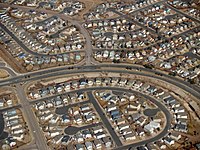
Photo from wikipedia
ObjectivesThis study investigated the association of built, natural and social environment variables with the practice of physical activity (PA) during leisure time and commuting.MethodsHousehold interviews were carried out with a… Click to show full abstract
ObjectivesThis study investigated the association of built, natural and social environment variables with the practice of physical activity (PA) during leisure time and commuting.MethodsHousehold interviews were carried out with a representative sample of individuals aged 18 years or older from a municipality in southern Brazil. PA was measured by the International Physical Activity Questionnaire, and households were georeferenced with a 500-m buffer.ResultsFew associations between environmental variables and PA practice were identified. Only proximity to the seafront, presence of private gyms or sports clubs and higher average monthly income of the household head were associated with the practice of PA. In addition, there were inconsistencies in the findings showing that the associations varied based on the intensity and modality of PA within the same domain.ConclusionsThis study provides evidence on the lack of association between objective environmental measures and the practice of PA. Although there were few significant results and the presence of inconsistencies in the findings, some environmental variables were associated with a more frequent practice of PA.
Journal Title: International Journal of Public Health
Year Published: 2019
Link to full text (if available)
Share on Social Media: Sign Up to like & get
recommendations!